The Living Seoul Attractions
 Seoul Botanic Garden & Park, Maguknaru Station, Seoul
Seoul Botanic Garden & Park, Maguknaru Station, SeoulLiving Seoul Attractions
Living Seoul Attractions page briefly features the leading travel and exciting spots, parks, structures, places, museums, galleries, shops, government buildings, and anything that attracts your unique tastes.
This page includes over 180 items that could be of interest. Check out its individual links to find more exciting descriptions, guides, and photos.
Since Seoul Attractions strictly features items about Seoul, you cannot find anything outside it. Please, see the attractions above if you want to visit other cities, such as Busan, Gyeongju, Jeju, Gwangju, etc.
You can also find resources for travel to various provinces through here. Now, let me start presenting your briefs of Seoul's attractions...
313 Art Project
This art gallery is amid Apgujeong's contemporary slick and chic art hub. It is the center for artists from both local and international backgrounds.
63 Sky Art Gallery
The top-class, regularly changing art exhibitions at this 60th-floor gallery, have the extra thrill of an observation deck. It's held within the gold-tinted glass skyscraper 63 City, which also features some humans.
Another Way of Seeing
This facility runs a program that supports art education and related activities for the blind students. Another Way of Seeing exhibits the thought-provoking arts which play on senses other than sight, such as smell, touch, hearing.
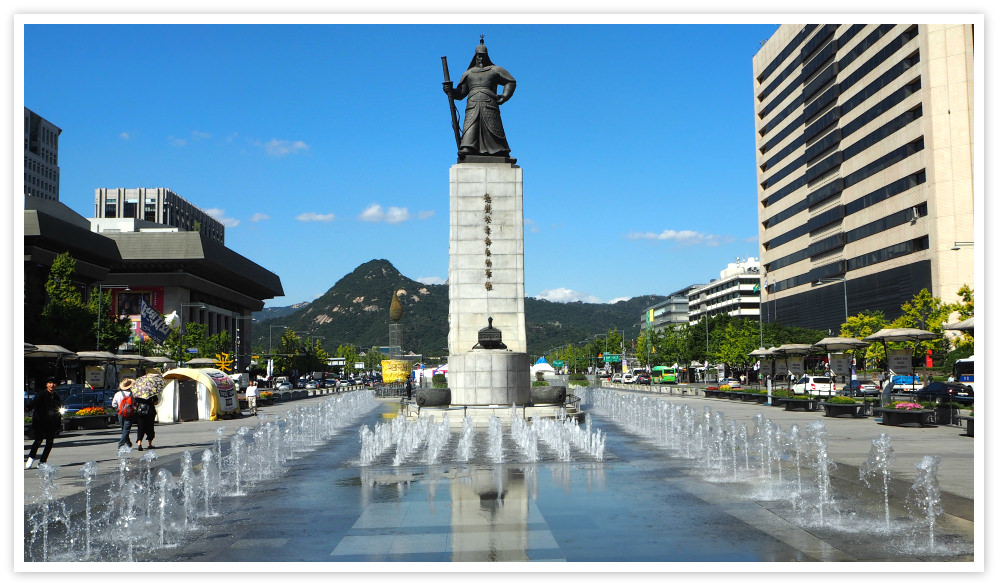
Admiral Yi Sun-Sin Statue
This statue is a landmark in Seoul's Gwanghwamun Square. Yi Sun-sin (1545–98) designed new types of metal-clad warships called 'geobukseon' (turtle ships) and used them to help achieve a series of stunning victories against the Japanese invaders in Yeosu.
Ahn Jung-geun Memorial Hall
In a striking modern building on the west flank of Namsan, this well-structured museum is dedicated to Korean fallen independence fighter Ahn Jung-geun. Ahn assassinated Ito Hirobumi, the Japanese governor-general of the nation under the Imperial Japanese army.
Agriculture Museum
This museum in Seoul has imaginative displays of replicas of tools relating to the history and practice of farming on the Korean peninsula through the dynasties.
Artsonje Center
Founded in 1998, Artsonje supports experimental art, runs workshops, and has lectures as well as an annual Open Call for new works. Also here is a cafe and arthouse cinema. It is also the Seoul outpost for the fascinating sights.
Arario Museum in SPACE
Korean business magnate and contemporary-art collector Kam Chang-il have found the perfect home for jewels from his collection at this ivy-clad brick building that's considered a seminal piece of early-1970s architectures, among others.
Arko Art Center
A great place to explore contemporary arts, this impressive red-brick complex has triple interlinked galleries that house regularly changing, often avant-garde exhibitions. The gallery was first established in 1979.
Artside
Since 1999, Artside took a leading role in the artistic exchange between Korea and China. Artside regularly exhibits new art items by contemporary Chinese artists such as Zhang Xiaogang.
Bank of Korea Money Museum
Established in 1912, and an outstanding example of Japanese colonial architecture, this old Bank of Korea now houses a reasonably exciting exhibition on the history of local and foreign currency.
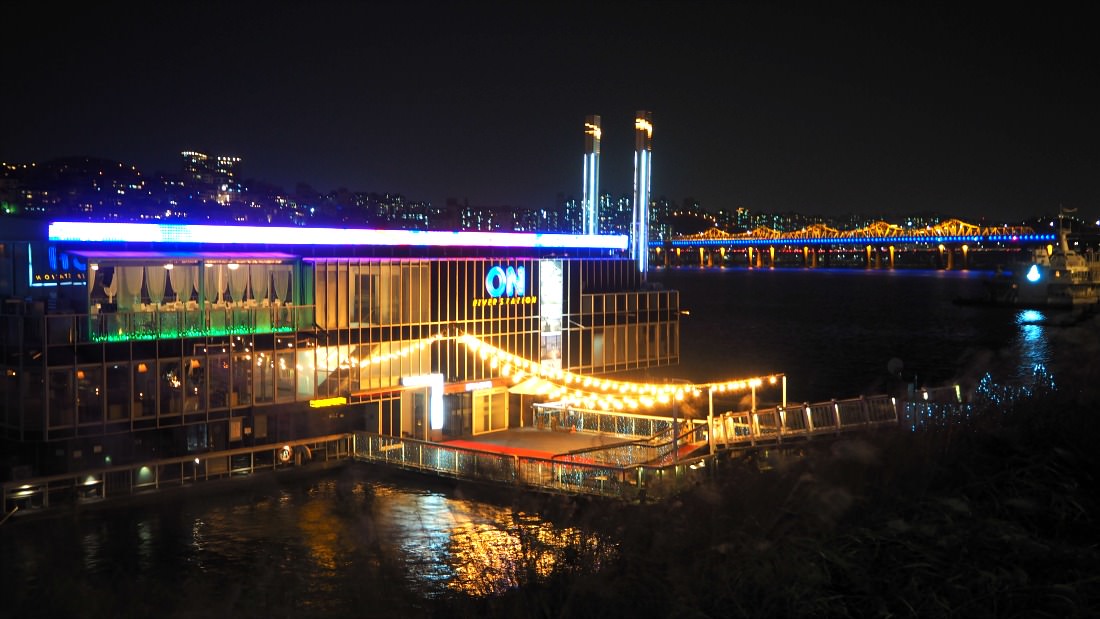
Banpo Bridge Rainbow Fountain
Adorned with 10,000 lights, the Banpo Bridge Rainbow Fountain's colored water rains down in messy arcs from the double-leveled Banpo Bridge. The bridge, spanning 1140m, is considered the world's longest city bridge with such features.
Bongsudae
Near the summit of Namsan, you can see the Bongsudae, a smoke-signal communications system used for 500 years to notify the central government of vital political and military information.

Bosingak (Buddhist Bell)
Contrasting with the modern Jongno Tower
across the avenue, this ornate pavilion houses a recent copy of the
original Buddhist city bell. The original one, forged in 1468, is in the
garden of the National Museum of Korea.
Bukchon Traditional Culture Center
There's an informative exhibition about hanok homes and the Bukchon area, housed in this larger-than-average hanok. It's generally unstaffed, but sometimes you may find English-speaking volunteers here.

Bongeunsa Temple
Located in the heart of ritzy Gangnam District, the shrines and halls of the Buddhist temple Bongeunsa Temple, with its tree-filled hillside location, stand in direct juxtaposition to its corporate high-rise surrounding. Please, read and see more photos here.

Bukchon Hanok Village
Meaning 'North Village,' Bukchon, between
Gyeongbokgung and Changdeokgung, is home to around 900 hanok, Seoul's
largest concentration of these traditional Korean homes. Please, you may read my article here or see more photos I took.

Changdeokgung Palace
The World Heritage-listed Changdeokgung Palace is the most beautiful of Seoul's five main palaces.
Joining a guided tour is worth your one-hour effort. But exploring alone freely is also an exciting experience. See more photos and read the article here.

Cheonggyecheon Stream Park
With its landscaped walkways, footbridges, waterfalls, and a variety of public artworks, such as the enormous pink-and-blue shell entitled Spring in Cheong-gye Stream Plaza, this revitalized stream is a hit with Seoulites.
Cheondogyo Temple
Cheondogyo means 'Religion of the Heavenly Way,' and this temple is the hall of worship for a home-grown faith containing Buddhist, Confucian and Christian elements that gathered momentum in the 1860s.
Children's Grand Park
Kids can run wild in this enormous playground, which includes amusement rides, a zoo, botanical garden, wetland eco area, and a giant musical fountain. The Children's Museum is the latest attraction added.

Cheong-gye Plaza
Houses the towering pink-and-blue shell artwork and landmark entitled Spring. Part of the Cheonggyecheon pathway, there is always movement day and night here, whether from fountains or light displays. Please, read the article here.
Central Buddhist Museum
Jogyesa Museum has three galleries of antique woodblocks, symbol-filled paintings, and other Buddhist artifacts. Take a break after exploring at their cafe closeby.

Cheongwadae (Blue House)
Security is so tight around the Blue House (so-called because of its blue-tiled roof) at the base of Bukaksan that even innocently walking past the presidential residence is likely to get you stopped and questioned. Read more about Cheongwadae or the Blue House.
Cheongwadae Sarangchae
Much more interesting than the tour of Cheongwadae is its exhibition hall opposite the exit from the presidential compound. Inside are exhibits promoting Korea and Seoul as well as the work of past presidents.

Culture Station Seoul 284
Culture Station Seoullo 284 is formerly part of Seoul Station. This old 1925 building with a domed roof has been beautifully restored inside and out and made into a cultural-arts space staging a variety of free events.
Choong Ang High School
The Gothic-style early-20th-century buildings of this campus are recognized as part of Seoul's cultural heritage. It also offers a nice contrast with the surrounding traditional hanok architecture of Bukchon.
Cheonggyecheon Cardboard House
This 'cardboard' slum house, typical of the wooden shacks that lined the Cheonggyecheon after the Korean War, has been preserved to give a sense of life for Seoul's urban poor in the 1960s and '70s.
Changuimun
One of the 'four small gates' in Seoul's City Wall, this is also the start point for the City Wall hike up Bukaksan. If you plan on doing the hike, you'll need to show your passport at the booth by the gate.
Changgyeonggung Palace
Changgyeongung was initially built in the 15th century by King Sejong. This palace is one of Seoul's 'five grand palaces.' It is located close to the more impressive Changdeokgung – the two palaces shared the now-famous secret garden.
Choi Sunu House
The charming hanok (traditional wooden home) of Choi Sunu, a former director of the National Museum of Korea and academics on Korean arts, is now looked after by the National Trust of Korea.
Citizens Hall
Head down to City Hall's basement to reach Citizens Hall, a multipurpose space with an exciting mix of multimedia art exhibitions, design shops, and a fair-trade cafe.
Cheonggyecheon Museum
To fully comprehend what expensive effort to resurrect Cheonggyecheon, Seoul's long-buried east-west stream, pay a visit to this excellent museum. It's also a good starting point for a walk along this revived old stream.
Daehan Empire History Museum
This excellent museum has its opulent lobby, dining rooms, and bedrooms. It is in the neoclassical-style Seokjojeon. Visiting this history museum is only possible by booking a free 45-minute tour online or upon arrival.
Dongdaemun History Museum
Attached to the DDP, this museum makes up a part of the Dongdaemun History and Culture Park. It features archaeological remains from the Joseon dynasty that were uncovered during the site's excavation.

Deoksugung Palace
Deoksugung Palace is one of Seoul's five grand palaces constructed during the Joseon dynasty period. "Deoksugung" (translation: Palace of Virtuous Longevity) is the only palace you can visit in the evening and see the buildings illuminated. Read my article here.

Dongdaemun Design Plaza & Park
Designed by the late Zaha Hadid, this Neo-futuristic cultural complex was commissioned to replace the Dongdaemun Stadium, built during Japanese rule in the 1920s. Dubbed the 'most massive three-dimensional atypical structure, it is attracting huge crowds daily. See my article here.
Deoksugung Stone Wall Road
Outside to the left of Deoksugung Palace's main gate, the palace's stone southern wall creates a curve-shaped path shaded by 130 trees with benches underneath. Locals and visitors stop by and rest or take selfies and groupies.
Daelim Contemporary Art Museum
Daelim specializes in exhibiting photography, designs, and fashion. The building, which was once a family house, but was remodeled by French architect Vincent Cornu. Its lovely garden and other features attract visitors.
Dongdaemun Stadium Memorial
This memorial is part of the Dongdaemun History and Culture Park. It is very engaging that can relive key moments from the former stadium's history. In 1925, the Japanese built it and was used primarily for soccer and baseball matches and similar entertainments.
Eungbongsan Park
For spectacular vistas of the Han River and Eastern Seoul, take a short hike up the steps to the pavilion atop Eungbongsan. Eunbongsan Mountain Park boasts its verdant sights and colorful flowers in the Spring season.
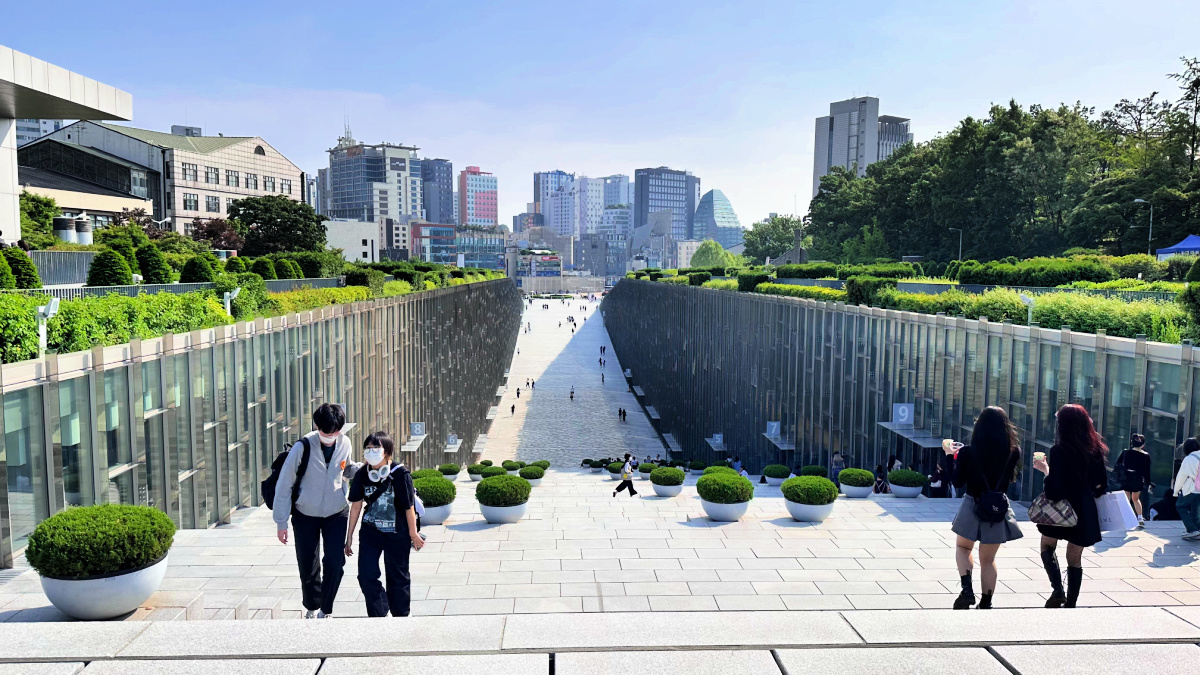
Ewha Woman's University
Come to this venerable university, founded in 1886 by American Methodist missionary Mary Scranton, to view Dominique Perrault's stunning main entrance. Read more about this famous women's university in this article.
Ewha Woman's University Museum
To the left of the university entrance, the exhibits spread over three floors here conjure up the extinct world of the yangban (aristocratic) elite with beautiful examples of their refined taste in ceramics, art, and other exciting exhibitions.
Fifty Fifty
A decent art gallery with a fantastic space for its regularly rotating art shows by emerging local artists.
Football Faentasium
This interactive museum with various displays at the World Cup Stadium & Mall is a must for football fans, despite the pricy admission fee. The Korean football history and its players in the K League are detailed through modern displays.

Gangnam Style Sculpture
The Gangnam Style, the horse dance in Psy's music video has been iconified as a giant pair of bronze hands. You can see it on a stage on the east side outside COEX Mall.
The song plays as you approach it. It would lit up at night to entertain you. Read more about the sculpture here.
Gungisi Relics Exhibition Hall
Head down to the basement of City Hall to this glassed-in archaeological site displaying items dating from the Joseon dynasty unearthed during the excavation of the complex, including arrowheads and firearms.
Gahoe Minhwa Workshop
Gahoe Minhwa houses an extensive collection of amulets and folk paintings. This combined house museum and the cultural center also offers classes teaching traditional art, which can be done as a print or on a T-shirt.
Gwanghwamun Square Underground Exhibition
This underground exhibition displays the life and achievements of King Sejong and his Korean language invention. Try writing your name in Korean with brushstroke and ink for free and take away your Korean language achievement.
Gallery Simon
Exhibitions include sculptures and exciting installations. Has a chic top-floor cafe with views over hanok roofs.

Gwanghwamun Gate
The impressive main gate to Seoul's premier palace is flanked by stone carvings of 'haechi,' mythical lion-like creatures traditionally set to protect the palace against fire. This is the main gate of the most famous Gyeongbokgung Palace in Seoul.
Gangnam Style 'Horse Dance' Stage
Coming out of Gangnam Subway Station, you'll see the multimedia Gangnam Style stage, a shrine for Psy where you can pose for selfies or any. Its establishment is somewhat ironic since the song was a parody of the neighborhood.
Gonsindang
On the right-hand side of the entrance to Jongmyo, the World Heritage-listed Confucian shrine, this building houses the spirit tablets of 83 royal family members. They served their kings well and were rewarded with …
Gallery Hyundai
The trailblazer for Korea's contemporary commercial-gallery scene, Hyundai, has been going strong since 1970. The gallery exhibits some of the giants of the site, including Lee Joong-seop and Paik Nam June.
 Inside Gyeongbokgung Palace, Seoul, South Korea
Inside Gyeongbokgung Palace, Seoul, South KoreaGyeongbokgung Palace
Gyeongbokgung Palace is the top tourist attraction in Seoul. The palace is the largest one in Seoul and the most attractive among the five palaces. It suffered destructions during the Japanese war but has risen several times from the ashes. Learn its historical background, including the thousands of government officials, scholars, eunuchs, concubines, soldiers, and servants who lived here. Please, read more and see more photos in my article here.
Gwanghuimun
The 'southeast gate' of Seoul's fortress wall, Gwanghuimun, is far smaller and more modest than Heunginjimun. It was rebuilt in 1976.
Gyeongui Line Forest Park
This 6.3-kilometer park, named for the former Gyeongui Line, is a narrow, long green space that runs along the discarded railroad tracks above Gajwa Station to Hyochang Park station.
Gilsang-sa Temple
This modern hillside temple is a pleasure to visit at any time of the year, but particularly in May when the grounds are festooned with lanterns for Buddha's birthday. The buildings once housed the elite restaurant.
Great Greenhouse
On the grounds of Changgyeonggung is this splendid Victorian-style greenhouse built by the Japanese in 1909.
GT Tower East
The curvaceous stylings of the slinky GT Tower sit beside the significant crossing of Teheran-no and Gangnam-daero.

Gwanghwamun Square
This broad, elongated square provides a grand approach to Gyeongbokgung and is used for various events (as well as protests). Giant statues celebrate two national heroes: Admiral Yi Sun-sin, 1545–98, and King Sejong, the inventor of Hangeul language. Please, see my article here.

Gyeonghuigung Palace
Gyeonguigung Palace, completed in 1623, used to be composed of many courtyards, buildings, walls, and gates spread over a large area. When the Japanese came, the whole establishment was burnt down. It is reconstructed and looks excellent as it fronts the beautiful Inwangsan Mountain in the background. You may read my article here.
Gyeongui Line Book Street
This extension of the Gyeongui Line Forest Park is a book-themed pathway of bookshops housed in train-carriage-like containers. The street commemorates the high concentration of publishing companies in the area.
Hanyangdoseong Exhibition Hall
Adjacent to Hyehwamun, this former home of various mayors of Seoul was built in 1941 directly on top of the Seoul City Wall. It's now a Wall museum with a small cafe and garden, and a popular rest spot for strollers and joggers.
Hongneung Arboretum
A hidden gem, the National Institute of Forest Science, opens its idyllic grounds to the public on weekends. A forest pathway winds for a few kilometers between rare trees and herb gardens. A royal tomb is accessible for viewing nearby.

Hyehwamun Gate
Hyehwamun gate is one of the 'four small gates' of the Seoul City Wall. Hyehwamun is also known as Dongsomun (translation: small east gate). Initially built in 1396, Hyehwamun Gate was reconstructed in 1994 on this spot slightly to the north of its original position.
Hammering Man
Constructed in 2002 with 50 tonnes of steel by an American artist Jonathan Borofsky, this 22-meter-tall black human-shaped structure of a blacksmith is still in motion. The statue provokes thoughts about labor.
Hwabong Gallery
Cutting-edge Korean art is usually on show in this basement alongside permanent displays of the smallest book in the world (no more than a dot), and the most giant book.
Hamnyeongjeon
A part of Deoksugung, this building served as Emperor Gojong's living quarters.

Heunginjimun (Dongdaemun Gate)
The Great East Gate to Seoul's City Wall has been rebuilt several times in its 700-year history, and, after recent renovations, it's looking majestic.
Heunginjimun is located to various relaxing and entertaining places in Dongdaemun Market area. Check out this article.
Horim Museum
Within the lustrous walls of the stylish Horim Art Center, this museum has three floors devoted to Korean ceramic masterpieces and temporary exhibits on traditional Korean art.

Jeonggwanheon Hall
Within the Deoksugung Palace complex, the entertaining fusion-style pavilion Jeonggwanheon was designed by Russian architect Aleksey Seredin-Sabatin. It served as a place for the emperor to savor coffee and entertain guests.
Huwon
Huwon is an excellent place for short strolls. You can walk through the dense woodland at the rear of the main buildings of Changdeokgung. Huwon has a beautiful vista of pavilions on the edge of a square lily pond, among other interesting sights around.
Hakgojae
This elegant gallery is easy can be recognized quickly by the robot sculpture on the roof of its modern section. Entry is via the converted hanok building, which neatly symbolizes the gallery's aim 'to review the old to learn the recent development.

Heunghwamun Gate
This is a large and impressive entrance gate to Gyeonghuigung Palace. In its lifetime, Heunghwamun has toured around Seoul and was finally returned to its present site in 1988. I see this gate everyday as it is across where I work.
Inwangsan Guksadang
This ornate shrine located atop Inwangsan Mountain is one of Seoul's most popular sites for shamanism. Shamanism is Korea's traditional, highly ritualized, and somewhat taboo folk religion. They still perform offerings to spirits regularly.
Itaewon Bugundang History Park
Even up to this day, longtime residents of Itaewon might be surprised if you tell them that it is indeed possible to find relics in the heart of the neighborhood. Located atop a hill facing N-Seoul Tower is the panoramic history park of Itaewon.

Jongno Tower
Designed by Rafael Viñoly, this striking 33-story office building with floating oval lords it over low-rise Insa-dong. It has a fancy restaurant and cocktail bar Top Cloud on its top floor. I believe it is the only unique structure in Jongno area. It has an underground Solar Garden being supported by sunlight being channeled through special mirrors.
Jeongdok Public Library
The small quiet park fronting the public library is an excellent spot for viewing cherry blossoms in SpringSpring, and the technicolor of Gingko Tree leaves in autumn. The library itself holds cultural events and houses over thousands of reading materials and other sources.
Jean Art Gallery
Pioneer of the Tongui-dong gallery scene and specializing in representing contemporary Korean and Japanese artists, such as Naru Yoshitomo and Yayoi Kusama: one of Yayoi's 2m-tall dotted pumpkin sculptures.
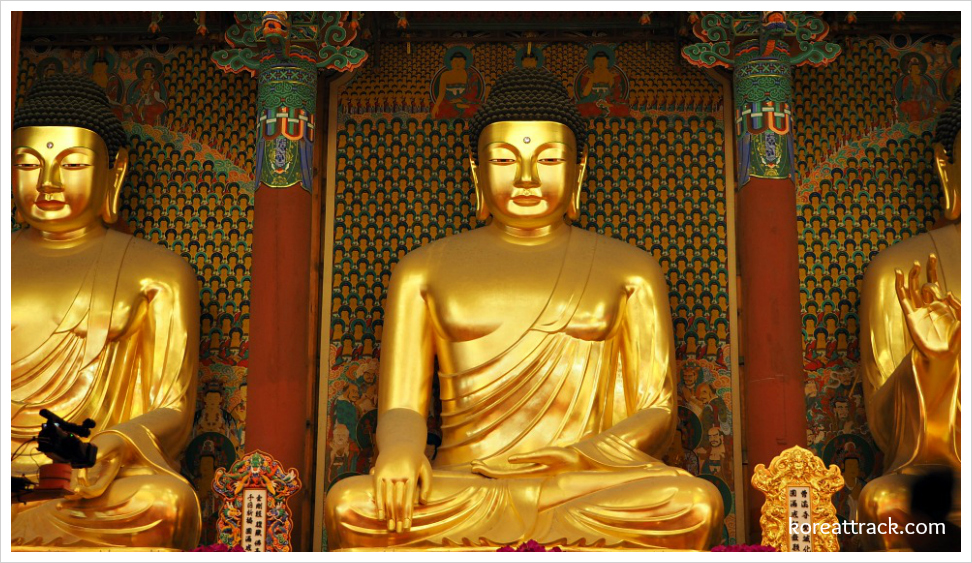
Jogyesa Temple
The focus of Jogye-sa is the grand wooden hall
Daeungjeon, Seoul's largest Buddhist worship hall, and the epicenter of
Korean Buddhism. Completed in 1938, its design followed the
Joseon-dynasty style. Please, read more about Jogyesa Temple here.
 The Red Gates at Jongmyo Shrine where the spirit tablets are being housed.
The Red Gates at Jongmyo Shrine where the spirit tablets are being housed.Jongmyo Shrine
Jongmyo Shrine is one of the top attractions in Seoul. It is within and surrounded by dense woodland at the heart of this capital city. The impressive buildings of the Confucian shrine house the spirit tablets of the Joseon kings and queens, including some of their most loyal government officials. Continue reading my article here...
Jeoldusan Martyrs' Shrine
Jeoldusan means 'Beheading Hill' – this is where up to 2000 Korean Catholics were executed in 1866 following a royal decree by the Japanese Imperial Army. Most of the martyrs were thrown off the high cliff here into the Han River. A Catholic church was built nearby to commemorate the martyrs' steadfast faith.
Junghwajeon
Serving as Deoksugung's main throne hall, Junghwajeon was used for ceremonial occasions such as coronations and is adorned with dragons and golden window frames.
K-Wave Experience
If you visit the Gangnam Tourist Center, you can possibly live out all your K-Pop fantasies. The makeup artist can transform you into a K-Pop star. You can choose from among your favorite K-Pop and wear clothing to look like them!
King Jeongjong's Tomb
The tomb of King Jeongjong (r 1506–1544) is one of three royal grave areas at Seonjeongneung Park. King Jeongjong was the second son of King Seongjong and Queen Jeonghyeon. Visit this park and experience serenity within the bustling city with verdant and colorful surroundings.
K-Star Road
If you've to Hollywood, you can also see something like it here in Seoul. Gangnam's 'Hallyuwood Walk of Fame' pays homage to K-Pop stars. Such attractions are in the form of cutesy bear sculptures dedicated to K-Wave singers and actors.

King Sejong Statue
This is a colossal statue of the revered scholar king (1397–1450) sits regally on a throne in the middle of Gwanghwamun Square. An entrance at the statue's base leads down to an underground exhibition with sections on the king and Admiral Yi Sun-Sin-inventor of the fierce 'Geobokseon' (Turtle Battle Ship).
King Seongjong's Tomb
King Seongjong's Tomb (1469-1494) is the most notable among the three royal tombs at Seonjeongneung park. He was a prolific author and a father of 28 children by 12 wives and concubines. Enjoy the park's refreshing and serene ambiance.
Korean Stone Art Museum
A score of centuries-old stone sentinels stands guard on the hillside at this terrific museum overlooking Seongbuk-dong. A road winds through sculpted gardens revealing collections of various stone figures.
Korea Furniture Museum
You need to apply several days in advance via a reservation page on the website to visit this museum. Still, you absolutely should come to admire the fabulous collection of Joseon dynasty chests, bookcases, chairs, and dining tables.
KT&G SangsangMadang
Funded by Korea's top tobacco company, this visually striking building is home to an art-house cinema, a concert space (hosting top indie bands), and galleries that focus on experimental, fringe exhibitions.

Kyobo Tower
The hulking 26-level brick edifice of Kyobo Tower (2003), designed by Mario Botta, is meant to be reminiscent of the bulkiness of Egypt's Sphynx. It is across Gwanghwamun Square various activities occur and where King Sejong and Yi Sun-sin statues can be found. Kyobo Bookstore, one of the largest bookstore, occupies the whole B1 floor of the building.
Kukje Museum
Kukje's two main gallery spaces are found off the main road, behind its restaurant building, which has the running woman sculpture by Jonathan Borofsky on its roof.
Lotte World Folk Museum
The Folk Museum at Lotte World uses imaging techniques like dioramas, scale models, and moving waxworks to bring scenes from Korean history to life. The price is included in the day-pass ticket for Lotte World Adventure Land.

Lotte World Adventure & Magic Island
Lotte World Adventure & Magic Island is a mainly indoor Korean version of Disneyland, complete with 'flying' balloons, 3D films, laser and music shows, screen rides, fantasy parades, and thrill rides. The surrounding Cherry Flower Trees of the artificial lake of the island enchant cherry blossoms lovers from across the globe.
Lock Museum
One of Seoul's quirkier private collections makes for a surprisingly absorbing exhibition. It specializes in the artistry of locks, latches, and keys of all kinds. Most of the items are local, but some of them are samples from other countries.

Lotte World Tower
Completed in early 2017, Seoul's towering landmark is the 555m-high Lotte World Tower. It is now the tallest skyscraper in Korea and the sixth highest in the world. Its sleek and modern design is thought to be inspired by the traditional Korean bamboo fan. You can read more about Lotte World Tower here...

Lotte World
This vast complex includes an amusement park, an ice-skating rink, a cinema multiplex, a department store, a folk museum, a shopping mall, a hotel, restaurants, and more. Kids and adults alike will love the place. Check out my article here...

Leeum Samsung Museum of Art
Amidst the celebrity-owned apartments on the leafy southern slope of Namsan is Korea's premier art gallery. Beautifully designed and laid-out structure, Leeum balances modern and contemporary art with traditional Korean architecture. See more about Leeum Museum here.
 Marronnier Park
Marronnier ParkMarronnier Park
More of a plaza than a park, Marronnier Park entices visitors and students in afternoons and evenings at its public stage. You can find some sculptures and performances by newbies practicing their skills. Besides, you can choose from the various restaurants and art centers surrounding the park. Belonging to the park is Daehangno Art Street, which is famous for various art forms and activities.
Mongchon Museum
Mongchon Museum exhibits precious golden relics made during the Baekje kings' reigns. A seven-pronged sword and the usual ancient pots are the most beautiful artifacts. The history of human settlement here goes back hundreds of years ago.

Myeong-dong Catholic Cathedral
Go inside this elegant, red- and grey-brick Gothic-style cathedral, consecrated in 1898, to admire the vaulted ceiling and stained-glass windows. The cathedral provided a sanctuary for student and trade-union protests during the past dictatorial regimes. See Myeongdong Cathedral page here.
Mullae Arts Village
Mullae Arts Village is located in Mullae-dong, a small industrial complex packed with metalwork factories. Local artists and designers have moved in beside the steelworkers and welders, bringing with them their talents and transform the area into a creative space.
Moonlight Rainbow Fountain Viewpoint
Moonlight Rainbow is a park that offers a spectacular vantage point of the nightly fountain show coming off Banpo Bridge. It is easy to access within the capital city of Seoul.
Modern Design Museum
This small museum displays items on its two floors trace the history of modern designs in Korea--from the 1880s to contemporary times. Not much is labeled in English, but it's still a fascinating collection to see for any interested visitor.
Myeongjeongjeon
The main hall of Changgyeonggung, Myeongjeongjeon, was rebuilt in 1616, making it a valuable example of 17th-century Joseon architecture, and the oldest surviving hall of all Seoul's palaces.
Museum of Gugak
The Museum of Gugak is part of the National Gugak Center. This engaging museum covers 'gugak' (traditional Korean music) with displays of Korean stringed musical instruments. Such musical instruments include unique drums, among others, that are rarely heard today.
MMCA Deoksugung
This branch of MMCA is within a grand colonial building inside the Deoksugung complex. It has several galleries exhibiting its permanent modern-art collection and temporary shows.
MMCA Seoul
Combining architectural elements from several centuries of Seoul's history, this branch of the city's premier contemporary-art museum is an impressive melding of spacious gallery buildings with the art deco building.
Mokin Museum
Mokin Museum displays carved and painted wooden figures and decorative motifs that were used to decorate 'sangyeo' (funeral carriages). Carved by village craftsmen, they are a unique folk art drenched in Buddhist and shamanist beliefs.
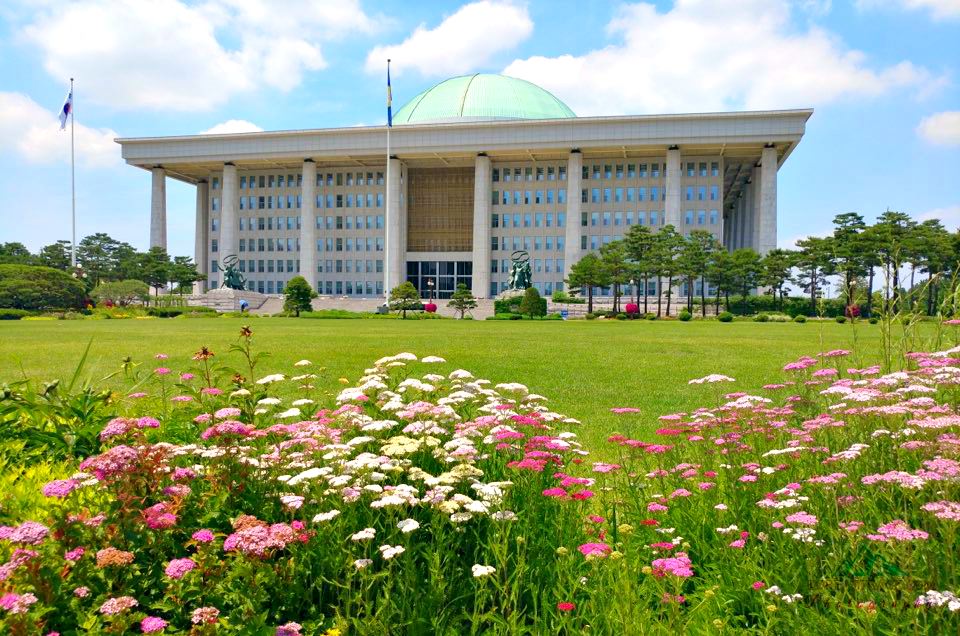
National Assembly Building
Home to South Korea's parliament since 1975, the pleasant grounds here with a fountain and an elaborate hanok (traditional wooden house; used for official functions) are worth a wander. You can read more details in my article about this building.
National Hangeul Museum
Learn a bit or better yet, a brush up your Korean language skills with this museum dedicated to the Korean alphabet called 'hangeul.' The Korean alphabet and writing system created in the 15th century. Take advantage of visiting the National Museum of Korea after your Korean language practice.

National Folk Museum of Korea
Learn the traditional Korean culture and practices at this museum. It has three separate exhibition halls, covering the history of the Korean people, their agricultural practices, and the life of yangban (aristocrats and officials in the old Korean society). Reade more about this interesting museum in my article.
Namsan Park
Beloved by locals, as well as foreign guests, as a place for exercise, peaceful contemplation, and hanging out with loved ones. Namsan Park used to be a sacred shamanistic spot when the Joseon ruler Taejo ordered the construction of a fortress wall across the Namsan Mountain.
National Museum of Korean Contemporary History
The last century in Korean history has been a tumultuous time for its people. The highlights and significant moments of its history are memorialized in this museum. You will see exhibits charting the highs and lows of that journey.
National Palace Museum of Korea
In a modern building in the southwest corner of Gyeongbokgung's compound, this museum displays royal artifacts that highlight the fabulous artistic skills of the Joseon era – royal seals, illustrations of official and social ceremonies, etc.
Namsan Botanical Garden
Namsan Botanical Garden can be reached from the Southern Namsan Circuit or via a pedestrian bridge over the road from near the Grand Hyatt is the Namsan Botanical Garden. The 59 square meters are divided into 13 themed gardens, including wildflowers, herbal, bushes, trees, among others.
National Children's Museum
Bring in your children to learn and enjoy the museum's exciting exhibits. Advance reservations are recommended for this interactive and guided museum for kids, as walk-in visitors are limited in number daily.
Naksan Park
The lofty slopes above Daehangno offer fantastic city views and contain an impressive section of the Seoul City Wall. You can stroll through in either direction (and often on both sides) between Dongdaemun and Seongbuk District.
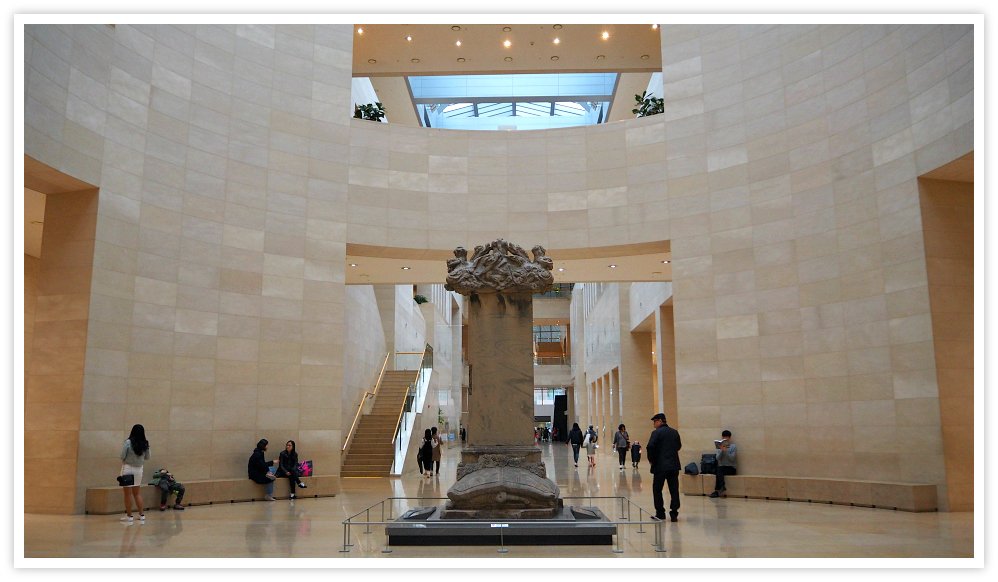 Inside the National Museum of Korea, Seoul
Inside the National Museum of Korea, SeoulNational Museum of Korea
The National Museum of Korea will transport you on a fascinating journey through Korea's past. You will learn Korea's prehistory all the way to the Korean Empire period (1897–1910). Make sure that you a lot of plenty of time to explore its vast collections. Eateries and cafes are available inside whenever you want to take a break. Please, see my detailed article of the National Museum of Korea here...
N Seoul Tower & Namsan
The iconic N Seoul Tower (236m), atop the city's guardian mountain Namsan, offers spectacles of this immense metropolis from its observation deck. If you come during sunset, you will be delighted by the sparkling lights of Seoul and its surrounding areas.
Noryangjin Fish Market
Providing terrific photo opportunities, Korea's most abundant fish market supplies every kind of aquatic life form to restaurants, fish shops, and the general public. Initially established in 1927 and relocated here in the 1990s.

Namdaemun Market
You could spend all day in this swarming night-and-day market and not see it at all. The largest market in Korea, each section has hundreds of stalls, from clothing to handicrafts and accessories. See more here
Namsangol Hanok Village
Located in a park at the foot of Namsan, this peaceful village is a beautiful spot to encounter traditional Korean culture. It features five differing 'yangbans' (upper class) houses from the Joseon era.
Open Air Exhibition
You can see this open exhibition just outside the National Folk Museum. It exhibits replicas structures, including a street of buildings styled as they would have been in the early 20th century.
Opera Gallery
This high-end commercial gallery is worth popping into for a gawk at works (and price tags) by artists such as Damien Hirst, Joan Miró, and Salvador Dalí as well as local contemporary painters.
Olympic Park
This large and pleasant park was the focus of the 1988 Olympics. Strolling its paths takes you past its stadiums surrounded by plenty of greenery, ponds, and open-air sculptures.
Oil Tank Culture Park
This unique park was originally built after Korea's first oil crisis in 1973 and reopened in 2017. This park is made up of five abandoned oil tanks. Constructed in a remote corner of Seoul, there is an other-worldly feeling as you enter into the area.
Prugio Valley
Appearing like a gigantic music speaker crossed with a slab of Swiss cheese, this incredible steel-clad building was designed by Unsangdong Architects. You can visit and take a selfie in a few minutes here.
Queen Jeonghyeon Wanghu's Tomb
Queen Jeonghyeon's Tomb is one of three royal tombs enshrined at Seonjeongneung park. Queen Jeonghyeon was the second wife of King Seongjong. See more here.
Ryugaheon
Based on a restored hanok, Ryugaheon specializes in photography exhibitions, but you may also see other types of art here, such as canvases of embroidered flowers. There are two display spaces and a small library of various sorts of resources.

Seoul Plaza
Seoul Plaza, or Seoul Gwangjang, is located in front of Seoul City Hall. It is very spacious and is the site for events and free performances most nights and even day time during summer. In winter, you can enjoy its outdoor ice-skating rink for a couple of months each winter season. Kids and adults love it!
SeMA Gyeonghuigung Museum of Art
Two large, white hangar-like structures make up this branch of the Seoul Museum of Art. Periodically changing exhibitions of variable quality and interest cover everything from traditional brush and ink to modern arts.
Sajikdan Altar
Located at the heart of Seoul but hidden on top of a small hill, Sajikdan Altar is an exciting place to visit. This stone altar in a tranquil park surrounded by low stone walls and ornate wooden gates dates back to 1395 and King Taejo. King Taejo, the founder of the Joseon dynasty, built the altar to offer prayers for good harvests.
Seoul Animation Center
Up the hill, on the way to the cable car, you'll find this museum and cinema devoted to cartoons and animation from Korea and beyond. It's part of a whole strip dubbed 'Cartoon Street', with comics-and-animation-related entertainments.
SeMA Nam Seoul Museum
Enclosed inside the former colonial Belgian consulate and beautiful building (c 1901), this branch of SeMA promotes itself as a 'living art museum,' with changing exhibits that range from furniture to various art forms.
Sool Gallery
Sool gallery is a small exhibition place with some English explanations to introduce you to various types of Korean alcohol, including makgeolli, soju, and yakju. If you come by booking ahead for the light tour, you at least get to sample four kinds of traditional wines.
Sun Art Center
Sun Art Center specializes in early 20th century Korean art. It offers awards to promising local arts annually. Sun is one of Seoul's oldest commercial art galleries started since 1977.
Samcheong Park
Located on the lower slopes of Bukaksan (mountain), Samcheong Park attracts throngs of the crowd, especially during the Springtime when the cherry blossoms are blooming. It is a great place to start a hike for the Seoul City Wall area.
SongEun ArtSpace
In the heart of Gangnam's fashionable Cheongdam district, this contemporary art gallery promotes works by emerging and established Korean artists with regular exhibitions over several floors.
Seoul Museum
The spacious modern galleries here have a variety of shows throughout the year. The highlight, though, is Seokpajeong, the elegant remains of a 19th-century wooden mansion, and parts of its landscaped grounds.
Seoul Forest
A hunting ground in Joseon times, this massive park offers several family-friendly attractions, including a sika deer enclosure, adventure playgrounds, butterfly and insect gardens, wetlands, and a skate park.
Sajin Changgo
Literally meaning 'photo warehouse,' Sajin Changgo is a rough-and-tumble gallery space showcasing edgy film photography from Korean artists.
Samsung D'Light
Spread over three floors, one of which is devoted to selling the latest lines of gadgets, this showroom showcases the technology of the Korean electronics giant Samsung.
SOMA
SOMA is a bunker-like art building that features modern and contemporary art in six galleries. Most are special paid exhibitions, covering both local and big-name international artists such as Frida Kahlo, among others.
Seoul Central Mosque
Its twin minarets rising tall and resplendent over 'Halal Hill,' Seoul's impressive mosque, which opened in 1976, caters primarily to the Arabic, Asian, and African immigrant worshippers who are settled in the Itaewon.
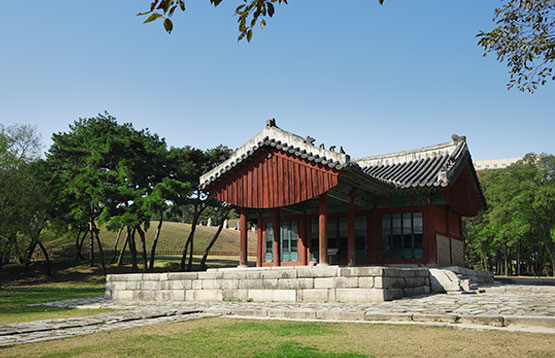
Seonjeongneung
Seonjeongneung Park contains two main burial areas for kings and queens from the Joseon dynasty. The first tomb is for King Seongjong (r 1469–94), who was a prolific author and father. Please, find out more details about this royal tombs area here.
Seoul Museum of Art
SEMA stands on a small hill in Seoul overlooking the Deoksugung Palace. SEMA has ultramodern, bright galleries inside the handsome brick-and-stone facade of the 1928 Supreme Court building. It has been hosting artworks from world-famous artists, aside from the local artists.
Seoul Metropolitan Library
Opened in 2012, the Seoul Metropolitan Library is within the original City Hall's Renaissance-style building, constructed in 1926, that's fronted by a clock. As well as a public library, there are photography exhibits accessible inside it.
Seonyudo Park
Seonyudo Park is a former water-filtration plant on an island in the Han River. It has been transformed into this award-winning park with great views of the river and surrounding environment. The old industrial buildings have been adapted as part of the new landscaping and gardens, which attracts both local and international visitors.
Sejong Gallery
Sejong Gallery offers current exhibits regularly. It is considered the most important cultural complex in Seoul. Visit the place located in the Gwanghwamun area to find insights into what's going on in the local contemporary art world.

Seoul Baekje Museum
Olympic Park's Seoul Baekje Museum illuminates the history and culture of Hanseong (18 BC-AD 475) when this part of Seoul was the capital of the Baekje kingdom.
 Sungnymun or Namdaemun Gate in Seoul
Sungnymun or Namdaemun Gate in SeoulSungnyemun Gate (Namdaemun Gate)
Famously called 'Namdaemun gate,' Sungnyemun is standing alone on an island, and one of Seoul's original four city gates built in the 14th century. Explore the gate and shop at the famous Namdaemun Market beside it. You can read my article here...
Seodaemun Prison History Hall
This prison museum was built in 1908. This former prison facility is a symbol of Korean suffering at the hands of Japan during the colonial occupation in the early 20th century. Unfortunately, it was also used by Korea's various postwar dictators to imprison dissidents opposing their rule. Please, read more here.
Seodaemun Independence Park
Apart from the former prison, this park, dedicated to those who fought for Korean independence, also features Dongnimmun, an impressive granite archway modeled after the Arc de Triomphe.
Stairway Flea Market
Held on the last Saturday of each month, this market attracts hundreds of shoppers to Usadan-ro on top of Itaewon Hill, where local artists sell their works on the stairs and set up stalls along the street.
Seoul K-Medi Center
This Medi Center is a clinic since the early Joseon Dynasty period. You can learn about the history and practice of traditional Korean medicine at this impressive facility.

Seoullo 7017
Seoullo 7017 is an overpass-turned-park is a green space in the heart of Seoul and near Seoul Station. Over twenty thousand plants are being cultivated on this overpass, including various types of flowers and trees. It is also more romantic when visited in the evening time due to its lights. Read my article on Seoullo 7017 here...

Seoul City Hall
Seoul City Hall is a modern structure made of glass and steel. This tsunami-looking Seoul City Hall was completely redeveloped in 2013 and is now a major architectural attraction in Seoul. Its design symbolizes dynamism and movement of water. The inside is decorated with green plants supporting the mayor's (Park Won Son) green environment vision.

Seoul Museum of History
Seoul Museum of History is the place to visit if you want to gain an appreciation of the total transformation of Seoul down to the present. Explore the museum to see its numerous fascinating displays, which exhibits the city's history since the dawn of the Joseon dynasty. In front of the museum, you will enjoy the fountain with its old map of Seoul. The old tram is also a sight idling nearby. Please, check out my article here...
Seoul Arts Center
Seoul Arts Center is in Seoul's center for its main events. Aside from its concert hall, it also has three art galleries. Seoul Calligraphy Museum is devoted to hand-drawn hangeul (Korean phonetic alphabet) and Chinese characters.
Seonjam Museum
An engaging little museum about Seongbuk-dong's long-vanished Seonjam altar, which was where royal sericulture (silk production) rites were held during the Joseon dynasty.

Seoul City Wall Museum
With interactive displays and historical
artifacts, this modern museum offers an engaging history of the
18.6km-long barrier that has enclosed Seoul since the late 14th century. You can read my article about this museum here...
SMTown Coexartium
This five-level interactive shrine to K-Pop in the
COEX Mall has already become a pilgrimage hot spot for fans since
opening in 2018. The photo hall is selfie heaven and includes the
albums, props, miniatures, and more artworks.
Seoul Olympic Museum
Seoul Olympic Museum is a great attraction for game enthusiasts and fans alike. It has been completely updated with an interactive museum to not only show highlights of the 1988 Olympics, but also the thrills of the Pyeongchang 2018 Winter Olympics. You can now find other memories from games recently held in the country.
Simsimheon
This modern hanok was rebuilt using traditional methods on the site of two older ones to create a home with museum grandeur that gives a rare opportunity to see inside a (splendid) residential property.

Sebitseom (Three Lantern Islands)
These three artificial floating islands interconnected by walkways represent the life of a seed, blossom, and a flower. Each plant-inspired structure features futuristic buildings in a complex that comprises restaurants, an exhibition hall, and outdoor observatories. Please, see my article here.
Starfield Library
More like a 13m-tall, neon-lit, designer shrine to books than a library, you can't actually take anything away here, but there are desks, sofas, and reading nooks for magazine flipping.
 Wongaksa (Temple) Stone Pagoda
Wongaksa (Temple) Stone PagodaStone Pagoda of Wongak-sa
This 10-tier and 12-meter-high ancient stone monument in Tapgol Park once graced Wongak-sa, a Buddhist temple that stood here. However, the temples were destroyed in 1504 on the orders of the Confucian king. Tapgol Park was once a center for democratic and independent movement during the Japanese occupation of the country.

Tapgol Park
Seoul's first modern-style park, opened in 1897, stands on the former site of Wongaksa, a Buddhist temple destroyed in 1504. Left behind was its remarkable 10-tier, 12m-high marble pagoda, which today is encased in a tall glass structure. Find out more about Tapgol Park in my article.
Tteok & Kitchen Utensil Museum
Sure, you do! And if you are interested in the local sweet culture, this two-room museum at the Institute of Traditional Korean Food offers displays of rice cakes in different colors, flavorings, shapes, and sizes, plus the utensils being used to create them.
Tangent
Hyundai Development Company hired Daniel Libeskind to work with Seoul-based firm Himma on its headquarters opposite COEX Mall. You can see this building just before entering COEX Mall located in Samseong Station, Seoul.

Unhyeongung Palace
This palace has a modest, natural-wood design reflecting the austere tastes of Heungseon Daewongun (1820–98), King Gojong's stern and conservative father. Rooms are furnished, and mannequins display the dress styles in the traditional Joseon period. Pre-wedding couples come for photo opts. My article is here.
Urban Hive
Above Sinnonhyeon Station is Urban Hive building, which was built like an enormous concrete beehive, giving it unique structural support, and is lit from within. It was designed by a famous Seoulite architect named Kim In-Cheurl.
War & Women's Human Rights Museum
In Korea, the survivors of sexual slavery by the Japanese military during WWII (known euphemistically as 'comfort women') are respectfully called halmoni (grandmother).
War Memorial of Korea, Yongsan
This war museum documents the history of the Korean War (1950–53) using multimedia exhibits, including black-and-white documentary footage. Inside the building, you can see artifacts like weapons, uniforms, and maps. You can also see the outside exhibits of the Korean War war machines--tanks, artilleries, airplanes, ships, etc.
Waryongmyo
Along the Namsan Northern Circuit, a pedestrian path that snakes for 3km from the lower cable-car station to the National Theater, you'll find the beautifully ornate and peaceful Waryongmyo. This was built in 1862 and is worth visiting.
World Peace Gate
Standing tall at the main entrance to Olympic Park is the colossal World Peace Gate. The gate has its striking winged arches designed by Kim Jung-up for the 1988 Olympics as the centerpiece of the large Peace Plaza. From the entrance, you can explore the park's varied attractions, including the artifacts of the Baekje dynasty.
Whanki Museum
Whanki Museum is an abstract museum in Seoul. Surrounded by sculptures, this fascinating museum showcases a rotating display of works by artist Kim Whan-ki (1913–74). Kim is a local pioneer of the modern abstract artist who is known as the 'Picasso of Korea.'
World Jewellery Museum
The well-lit displays of this private jewelry collection museum prove that small is beautiful. The pieces were a collection of unique items from around the world labored for over three decades.
Wau Park
On this hillside park, there are walking trails lined with wildflowers, as well as basketball and badminton courts and other fitness facilities. Most of these facilities are under the management of Hongik University and being used by its students.
World Cup Park
These five connected parks (Pyeonghwa, Nanjicheon, Nanji Hangang, Haneul Park, and Noeul) were created for the 2002 FIFA World Cup out of the former landfill and waste ground. Today it's one of Seoul's largest green spaces being enjoyed by visitors and locals.
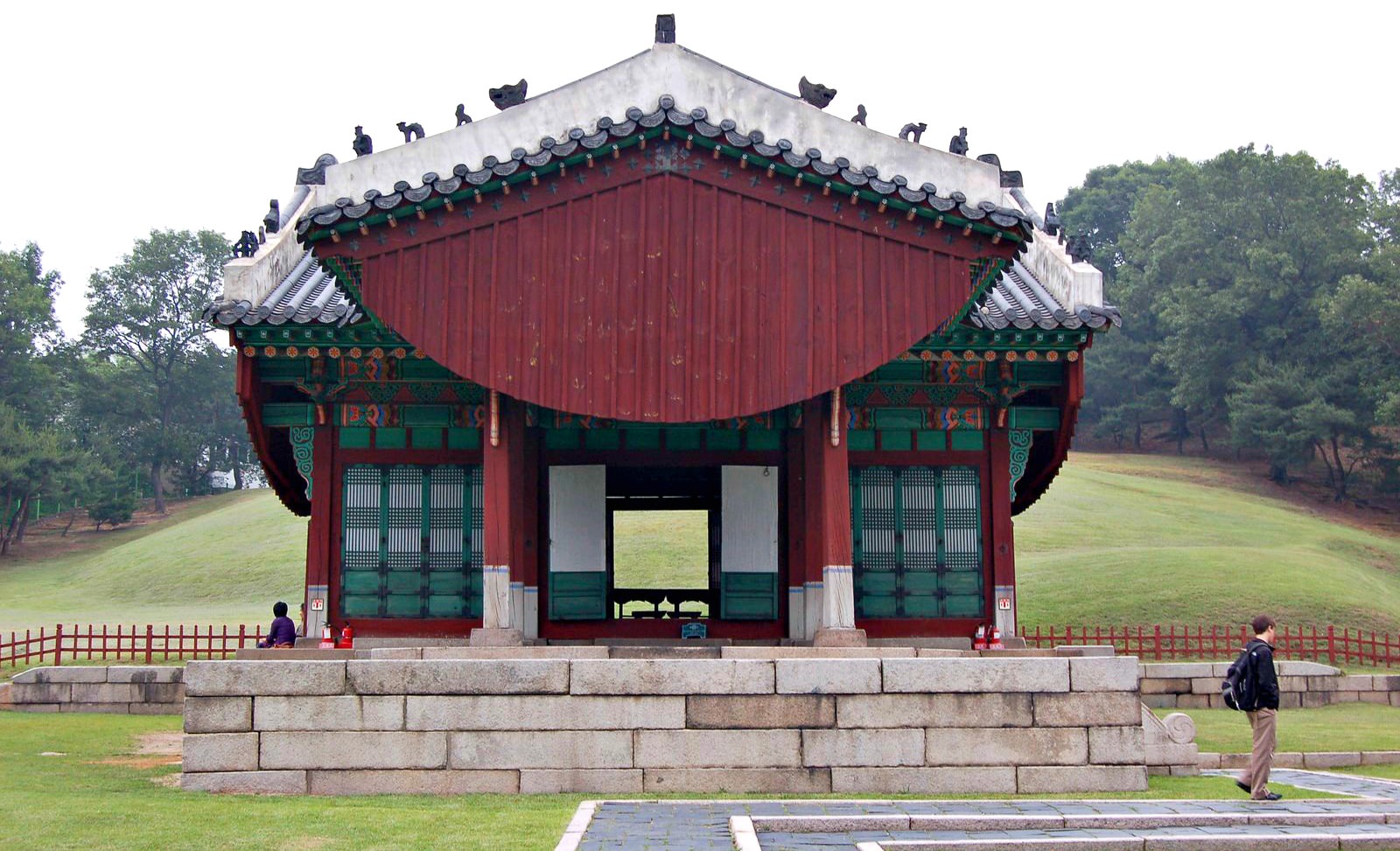
Yeonghwiwon and Sunginwon
Set in a tranquil, well-tended plot, this couple royal burial mounds date to the very end of the Joseon dynasty. Yeonghwiwon, the larger of the two, is the tomb of an imperial concubine who died in 1911. See more here.
This page will continue to grow in number of items as more attractions are created. That's why I call this the "Living Seoul Attractions" page.
I hope this is useful for your enjoyable travels.
Get Exciting Activities
Book one of our exciting activities today to experience the thrill of a lifetime! Take advantage of this opportunity and secure your spot in advance.
Hotel Map Guide
Find your affordable, accessible, and comfortable hotel in Seoul at Agoda.Com. See the hotel map below...
Hotel Booking Guide
Find affordable and amazing hotels on Agoda.com using the search box below. Book now to enjoy great discounts and save!




New! Comments
What do you think about this page? Leave me a comment in the box below.